



Gut health in poultry: the world within - update
Aviagen Brief - a gut health overview from Dr Richard A Bailey, poultry health specialist.Introduction
The efficient conversion of feed into its basic components for optimal nutrient absorption is vital for both broiler and broiler breeder production and welfare. Gut health, an intricate and complex area combining nutrition, microbiology, immunology and physiology, has a key role to play. When gut health is compromised, digestion and nutrient absorption are affected which, in turn, can have a detrimental effect on feed conversion leading to economic loss and a greater susceptibility to disease. In addition, recent changes in legislation on the use of antimicrobials, differing feed requirements and more efficient birds highlight the need for a better understanding of gut function and gut health. This article aims to explore the area of gut health and outline key factors that are important in the development and maintenance of optimal gut function.
An overview of the gut and how it works
The intestinal tract of a bird is a specialised tube that starts at the beak and ends in the cloaca. The primary function of the gut is the conversion and digestion of food into its basic components for absorption and utilization by the bird. The gut is separated into five distinct regions (Figure 1); the crop, proventriculus, gizzard, small intestine (duodenum, jejunum and ileum) and large intestine (ceca, colon and rectum). Each of these regions has a specific role in the digestion process and absorption of nutrients.

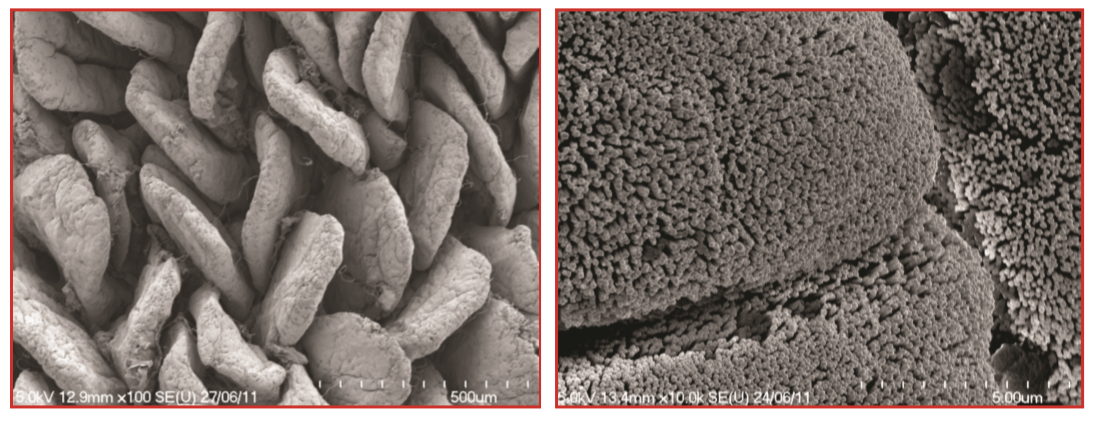
Electron micrograph of villi (left) and microvilli (right) of the small intestine.
The feed enters the crop where it is stored for a short period of time and partially fermented by the resident bacteria. The feed then enters the proventriculus where it is mixed with acid and pepsin (an enzyme which breaks down protein) and then on to the gizzard. The gizzard acts like a grinding mill to break the feed into smaller particles, it will then release the feed into the small intestine once the feed particles are small enough. While the gizzard grinds the feed, it is mixed with the acid and enzymes secreted by the proventriculus.
This process allows for the break down of whole proteins into smaller peptides which can then be digested in the small intestine into amino acids for absorption. Within the small intestine, the carbohydrates and fats are also broken down so that they can be absorbed and used by the birds. During the normal digestion process, by the time the digesta reaches the last part of the ileum all the proteins, fats and carbohydrates should have been absorbed leaving behind the non-digestible components of the feed (e.g., cellulose, non-starch polysaccharides, etc.).
This material has two fates; it is either passed out in feces or taken up by the ceca where bacteria ferment these materials to form organic acids, short chain fatty acids and vitamins which the bird can absorb for extra nutrients. At the end of digestion, chickens produce two types of droppings, a cecal and a fecal which look very different (Figure 3).

The fecal dropping (left) should form a semi solid bolus comprising of waste material with a white uric acid cap – this should be checked for abnormalities such as excessive water, fat, mucus and feed particles. The cecal dropping (right) should be dark in color, have a paste like consistency and be free of gas bubbles.
Gut Inhabitants – A World to Discover
The community of microorganisms in the gut is referred to in many ways: friendly bacteria, gut flora, gut microbiota and gut microbiome. It is a diverse community of mainly bacteria, fungi, protozoa and viruses. While modern DNA-based technologies have given a much more accurate picture of the bacterial species present in the gut, it has become increasingly evident that a large number of bacteria in the gut are currently unknown and unclassified. Recent studies focusing on poultry have proposed that the gastrointestinal (GI) tract of a broiler chicken is colonized by an estimated 600-800 species of bacteria.
The abundance and diversity of the microbiota varies along the GI tract and, predictably, the regions that have less tolerable conditions and faster passage of gut contents have lower numbers of bacteria. Even though bacteria can be found in the gut of the developing embryo, it is generally considered that the development of the adult gut microbiota predominately begins at hatching where bacteria are picked up from the environment, the feed and the people handling the chicks post-hatch.
The crop is rapidly colonized within 24 hours.
After one day post-hatch, the ileum and ceca are also both dominated by bacteria. After three days, the level of bacteria in the small and large intestine increases ten-fold.
The first bacteria to enter the gastrointestinal tract can be considered the pioneering bacteria as they rapidly multiply and colonize the gut environment. The composition of the pioneering bacterial community goes through a succession of changes as the gut develops and oxygen levels fall. It can take up to 3-4 weeks for the microbiota to form the climax (or adult) microbiota, but during this period, stability is seen in the gut if chicks are provided with optimal brooding conditions along with good feed and water quality.

The crop harbors a large population of lactobacilli. These bacteria partially ferment the carbohydrates in the feed and produce lactic acid which reduces the pH of the crop environment. The conditions within the proventriculus are highly acidic creating an environment which is unsuitable for most bacteria. The gizzard also has an acidic environment but has a substantial population of lactobacilli which mainly originate from the crop. The bacterial population of the small intestine is made up of mainly lactobacilli although enterococci, E. coli, eubacteria, clostridia, propionibacteria and fusobacteria can sometimes be found. The bacterial population of the small intestine evolves as the bird ages but will generally be stable by two weeks of age. The ceca provides a more stable environment which allows the colonization of slower growing fermentative bacteria. Early in the life of the chick, the ceca are dominated by lactobacilli, coliforms and enterococci, but by two weeks of age, the cecal environment will have started to stabilize as the adult flora begin to dominate. At this stage, the pioneering species are replaced with bacteroides, eubacteria, bifidobacteria and clostridia.
Role of the Intestinal Microbiota
Within the GI tract there are multiple interactions between the host (bird) cells, the intestinal environment, bacterial cells and feed components. These interactions emphasize the extremely important role of gut microbiota in the health and well-being of the host (as discussed below), although the exact way in which this is achieved is not yet fully understood.
The bacterial community of the intestinal microbiota form a protective barrier which lines the gut, preventing the growth of less favorable or pathogenic bacteria such as Salmonella, Campylobacter and Clostridium perfringens. This principle is most commonly known as competitive exclusion. Theories suggest that the commensal (or friendly) microbiota dominate attachment sites on the gut cells reducing the opportunity for attachment and colonization by pathogens. Another proposed mechanism is that the intestinal microbiota are able to secrete compounds, including volatile fatty acids, organic acids and natural antimicrobial compounds (know as bacteriocins), that either inhibit the growth of, or make the environment unsuitable for, less favorable bacteria.
Studies using germ-free animals have also shown that the intestinal microbiota is important in the stimulation and development of the immune system. It is thought that the commensal microbiota maintain the gut immune system in a state of ‘alert’ so that it can react quickly to pathogens. The gut microbiota is also considered to be an important factor in the development and maturation of the immune system.
Animals lacking a gut microbiota have been shown to be more susceptible to disease and have poorly developed immune tissues. In addition to protection against disease and stimulation of the immune system, the intestinal microbiota can influence host growth rates by producing extra nutrients through the fermentation of the plant fibers that the birds can’t digest.
The Balance of Gut Health
Gut health relies on the maintenance of the delicate balance between the host, the intestinal microbiota, the intestinal environment and dietary compounds. This balance can be significantly affected by factors such as bird management, feed quality and the birds’ environment. When gut health is optimal, there is complete digestion of the feed and absorption of the nutrient components. If there is a disruption to the normal processes in the gut, incomplete digestion and absorption of nutrients can occur, leading to malabsorption and gut imbalance. If there is any imbalance in the gut environment, gut health is then at risk of being compromised which can impact the health and performance of the birds. When digestion and absorption is not optimal, there is malabsorption of nutrients resulting in more nutrients being available to the small intestinal bacteria that can lead to an overgrowth of the bacterial population. A further consequence of malabsorption is the passing of proteins, sugars and fat into the ceca causing an overgrowth in the microbial population and a shift away from the beneficial fermentative bacteria. The balance of the microbiota in the gut can be affected by factors such as:
- poor gut development
- feed change
- feed (quality and raw materials)
- mycotoxins • biosecurity
- environment (temperature and ventilation)
- brooding conditions
- infections with viruses, bacteria or coccidiosis
- water quality
Diet has been found to be the most influential factor on the composition of the gut microbiota and Figure 4 below highlights how diet can change the gut flora.
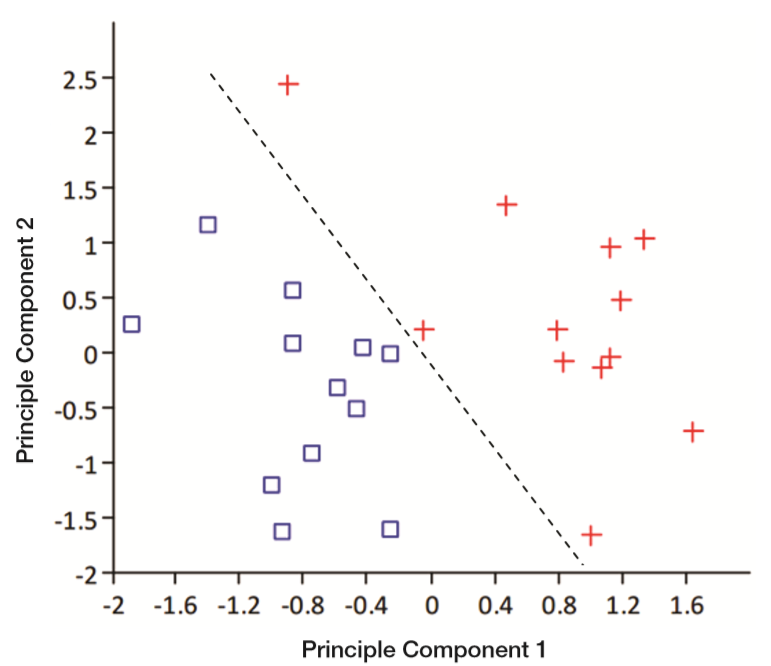
Principle Component Analysis of bacterial communities in the ceca of broilers fed on a high protein diet (+) (120 percent of standard diet) and low protein diet (▭) (80 percent of standard diet). Each point on the chart represents one bird fed one of the diets. The closer the points on the chart are the more similar the bacterial population in the ceca. We can see that there is a separation of the red points away from the blue points (as shown by the dotted line) indicating that the bacterial populations are different in the ceca between the birds fed on the different diets.
Changes in raw material type, nutrient density and feed form have all been shown to impact the microbiota. During the life of a flock there are a number of feed changes where there is a shift in composition of the diets; this invokes a change in the micronutrients available for the gut microbiota. The consequence of this change can be a minor bacterial imbalance in the gut as the microbiota adjusts to the new feed. This imbalance is usually of no consequence unless there are other factors impacting gut health at the time of the feed change.
Feed form is very important for gizzard function. Excess fines or poor pellet quality can result in the gizzard passing feed into the small intestine too quickly. If this occurs, there is not enough time for the acid and pepsin enzyme to break down protein resulting in whole proteins entering the small intestine which is detrimental as the small intestine cannot properly digest whole protein. When this happens there is protein malabsorption and increased viscosity in the gut, both of which increase the risk of dysbacteriosis and in severe cases may lead to necrotic enteritis. The use of cracked corn, whole wheat or insoluble fiber can help with gizzard stimulation to ensure optimal mixing of the feed within the gizzard.
Changes in the bacterial populations of the small intestine and ceca that occur during an imbalance is commonly referred to as dysbacteriosis and, if prolonged, can have negative effects on the host. The shift in cecal bacterial activity results in the production of different bacterial metabolites (the compounds produced by bacteria when they break down nutrients). Some of these metabolites, such as amines produced from bacteria metabolism of amino acids, can cause gut irritation making the ongoing gut upset worse.
The presence of certain bacteria is increased during dysbacteriosis and the action of these bacteria further affects nutrient absorption. For example, some bacteria can reduce fat absorption by inactivating the bile acids which bind to dietary fats for absorption. Other bacteria can destroy the surface of the villi reducing the surface area available for nutrient absorption. When nutrient absorption is reduced, it is not uncommon for birds to increase their feed intake in an attempt to meet their nutritional demands. This can lead to faster gut transit time, feed passage and wetter litter due to increased water intake.
If the gut is properly developed and the immune system is not compromised the impact of a gut upset on bird growth (and FCR) can be reduced. After the birds hatch and get access to feed and water the gut is triggered into its final stages of maturation. Biosecurity, shed hygiene and brooding management are all key for chick health and the establishment of a healthy gut. During the first week of life the gut undergoes rapid maturation with rapid growth of the intestinal villi; the length of the villi after this growth phase is critical as it dictates the length of the villi in the adult bird. If villi growth is compromised during brooding the result is shorter villi in the adult bird which will impact upon performance. Optimal villi growth relies on correct brooding management along with good feed and water quality. In the field it has been observed that the chicks receiving good brooding tend to develop a gut that performs well and has a greater capacity to cope with challenges in the chicken shed.
Water quality and line management are critical for the long term health of the gut; failure to monitor and promote water quality on farm can be detrimental to gut health and bird performance. Water management strategies depend upon water source (e.g. mains water or open source water), water hardness, water pH and mineral levels in water. Detailed below are the steps for ensuring the supply of clean water to birds.
What is Dysbacteriosis?
Dysbacteriosis is not a specific disease but a secondary syndrome. It is an imbalance in the gut microbiota as a consequence of an intestinal disruption. It results in poor nutrient absorption in the gut leading to poorer FCR and reduced live weight. If dysbacteriosis is severe enough it can contribute to wet litter.
The presentation of dysbacteriosis varies depending on severity but it is generally characterised by the production of wet feces and foamy cecal droppings. Post-mortem examination of affected birds reveals thinning of the gut wall along with gassy and watery gut contents. Dysbacteriosis can result from environmental stress, viral or bacterial challenge, coccidiosis or in response to feed change.
Dysbacteriosis can be treated with antimicrobial drugs; however it is preferable to use alternative treatments such as organic acids or probiotics if a gut imbalance is suspected.
If the primary cause of the dysbacteriosis is not identified it is likely to reoccur – therefore it is imperative to identify and rectify the cause of the intestinal disruption.
Water Quality
General water management protocol
- Ensure adequate cleaning between flocks:
- Remove biofilm (e.g. 25-50 ppm Hydrogen peroxide in water line for 24-72 hours then flush).
- Remove scale (target a pH of 5 with weak acid, e.g., Citric acid – leave in line for 24 hours then flush).
- Prior to bird arrival
- Use bleach solution in standing water.
- Flush just before birds arrive.
- Through life of flock
- Sanitize (e.g., Chlorine [2-4 ppm] or Chlorine dioxide [0.8 ppm]).
- Acidify water (pH 5.5-7).
- Perform waterline biofilm removal at regular intervals through life of flock (biofilms can form in 6 weeks).
- Routinely check ORP (oxygen reduction potential) at the drinker furthest from the water tank to check efficacy of sanitation; it should be >650 mv).
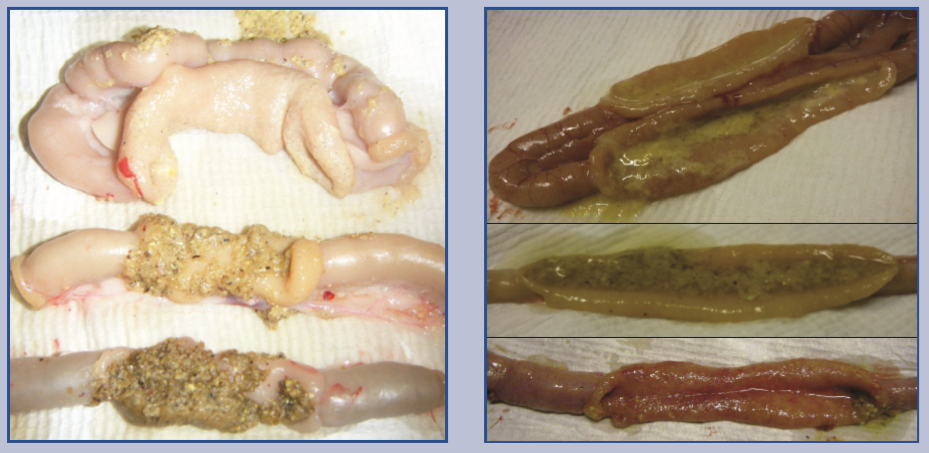
The colour of the gut surface, tone of the gut wall and the consistency of the contents are basic indicators of ongoing gut health and can help with the identification of the cause of the issue. The image on the left shows a healthy gut with the duodenum at the top then the jejunum and then the ileum. The gut surface is pink with the gut wall folding back on itself indicating good muscular tone. The transition of the content consistency and color are good indicating good digestion.
The images on the right show poor gut health from different birds. Here, the surface of the gut is seen to be inflamed, the gut tone is poor, and the contents consist of mucus and excessive fluid. These are all indicators of poor gut health and impaired digestion.
Gut Health Additives
There are many products available to support gut health, these products can either be added to water, added to the feed at the feed mill or top dressed on feed at the farm.
Gut health additives vary in their mode of action which makes choosing the right product difficult. Some gut health products provide or stimulate beneficial bacteria, some promote the development of the gut tissues, some aid digestion and others inhibit pathogens. Consequently, when deciding which product to use, it is critical to investigate what is causing the gut health issue and ensure that any potential product has the ability to help solve the issue faced.
These products often get called “alternatives to antibiotics” and they are used successfully in programs targeting a reduction in antibiotic use. However, it is important to recognise that their use is more preventative and thus their use should be considered as an alternative strategy. As part of a strategic approach, the aim is to administer a product that offers a solution to the needs of the gut at significant points in the chicken’s life.
The gut has three predominant stages; development, transition and maintenance (see Figure 5). During the development stage, the aim is to promote bacterial colonization and stimulate tissue and immune development. The transition stage refers to the time periods where there are fluctuations in the gut environment in response to impacting factors such as a feed change, vaccination and handling. These events can cause a change in the intestinal environment and increase the risk of malabsorption and bacterial overgrowth. The maintenance stage refers to the period when the gut has stopped developing and reached balance, however there is still the risk of disruption due to management or pathogen challenges, so it is still important to maintain support of the gut tissues at this time.
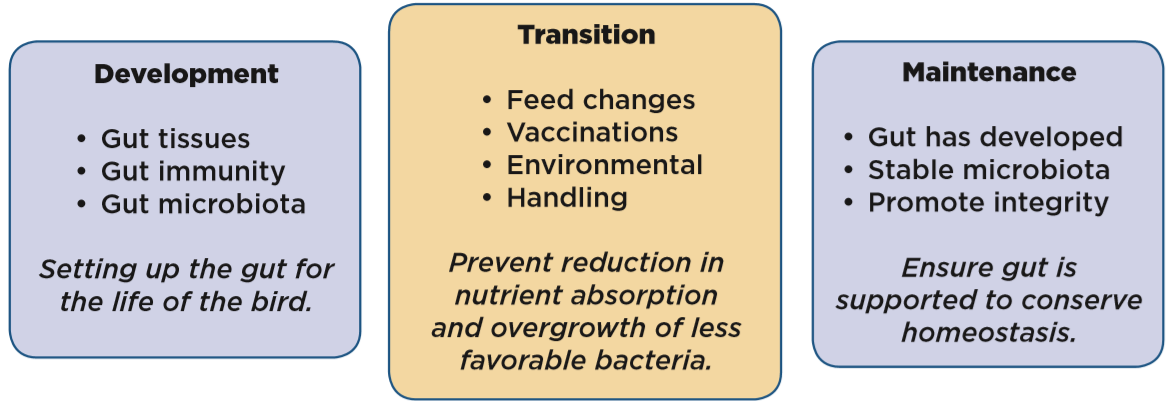
Understanding the needs of the gut at different points in the bird’s life and the main goals of gut health support at these times.
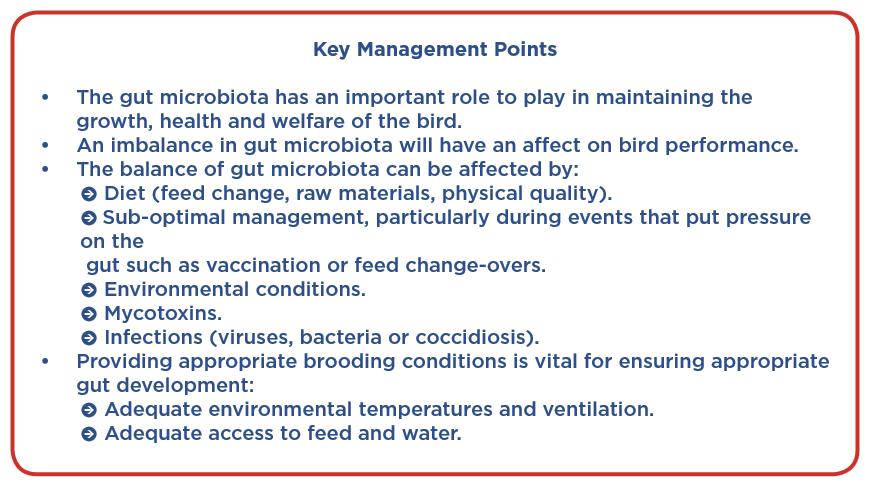
Gut Health Research
Gut health provides for an active area of research in both human and animal science. Aviagen® is committed to gaining a better understanding of gut flora, gut function and gut immunity by undertaking internal research projects and collaborating with universities to ensure the latest technologies and knowledge are exploited to improve bird gut health in the field.
Conclusions
Maintaining the balance of good gut health is a key aspect of getting the best growth and FCR out of any food producing animal. Many researchers have attempted to understand gut flora, gut function and gut immunity. It is increasingly evident that the gut remains a highly complex area. Regional variations in poultry production, management styles, climate, disease challenge and feed raw materials add further complexity to maintaining good gut health, but what is clear is that developing and maintaining gut health through good bird management practices is key to maintaining bird health, welfare and performance.










